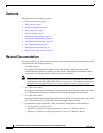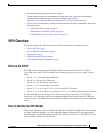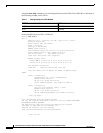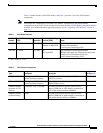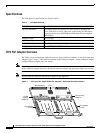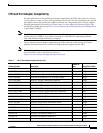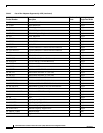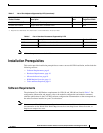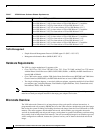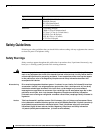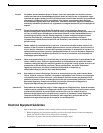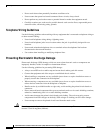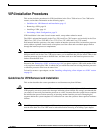
5
Fourth Generation Versatile Interface Processor (VIP4) Installation and Configuration Guide
OL-3673-01
VIP4 Overview
Table 2 outlines features of the VIP4 models, and Table 3 provides a list of the VIP4 internal
components.
Note You can use any combination of available CPU memory configurations and packet memory
configurations on the VIP4. You do not need to have equal amounts of CPU memory and packet memory
installed. (For information about upgrading memory, see the “Upgrading VIP4 Memory” section on
page 31.)
Table 2 VIP4 Model Features
Product
Packets Forwarding
(PPS)
1
1. PPS = Packets per Second
Bandwidth
Distributed Switching/
Services (DSW) Usage
VIP4-50 ~140,000 750+ MB Yes;
Moderate to high DSW
Distributed switching
Moderate link utilization
Cisco Express Forwarding (CEF)
VIP4-80 ~170,000 750+ MB Yes;
Very high DSW
High distributed switching performance
Multiple high-speed PAs with high link utilization
Extensive use of distributed IP services
Cisco Content Networking (CCN)
Table 3 VIP4 Internal Components
Type Size/Speed Description
Location
(see Figure 1)
CPU (for VIP4-50) 200 megahertz (MHz)
internal operating frequency
Reduced Instruction Set Computer (RISC),
IPSR5271 processor
CPU
CPU (for VIP4-80) 250 megahertz (MHz)
internal operating frequency
Reduced Instruction Set Computer (RISC),
MIPS R7000 processor
CPU
SDRAM DIMMs
1
(program or CPU
memory)
1. 8-bit error correction code (ECC), rather than byte parity, for single error-bit correction and double error-bit detection
64 (default), 128, or 256 MB 100-MHz synchronous dynamic random-access
memory (SDRAM) as CPU memory contained on
dual in-line memory modules (DIMMs)
U1
SDRAM DIMMs
1
(packet memory)
64 MB 100-MHz synchronous dynamic random-access
memory (SDRAM) as packet memory contained on
dual in-line memory modules (DIMMs)
U5




